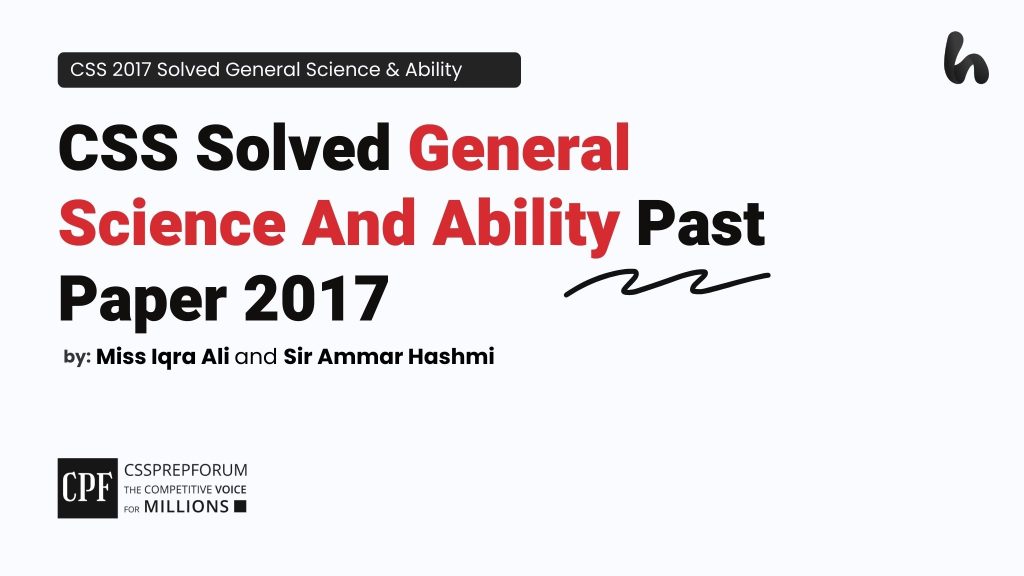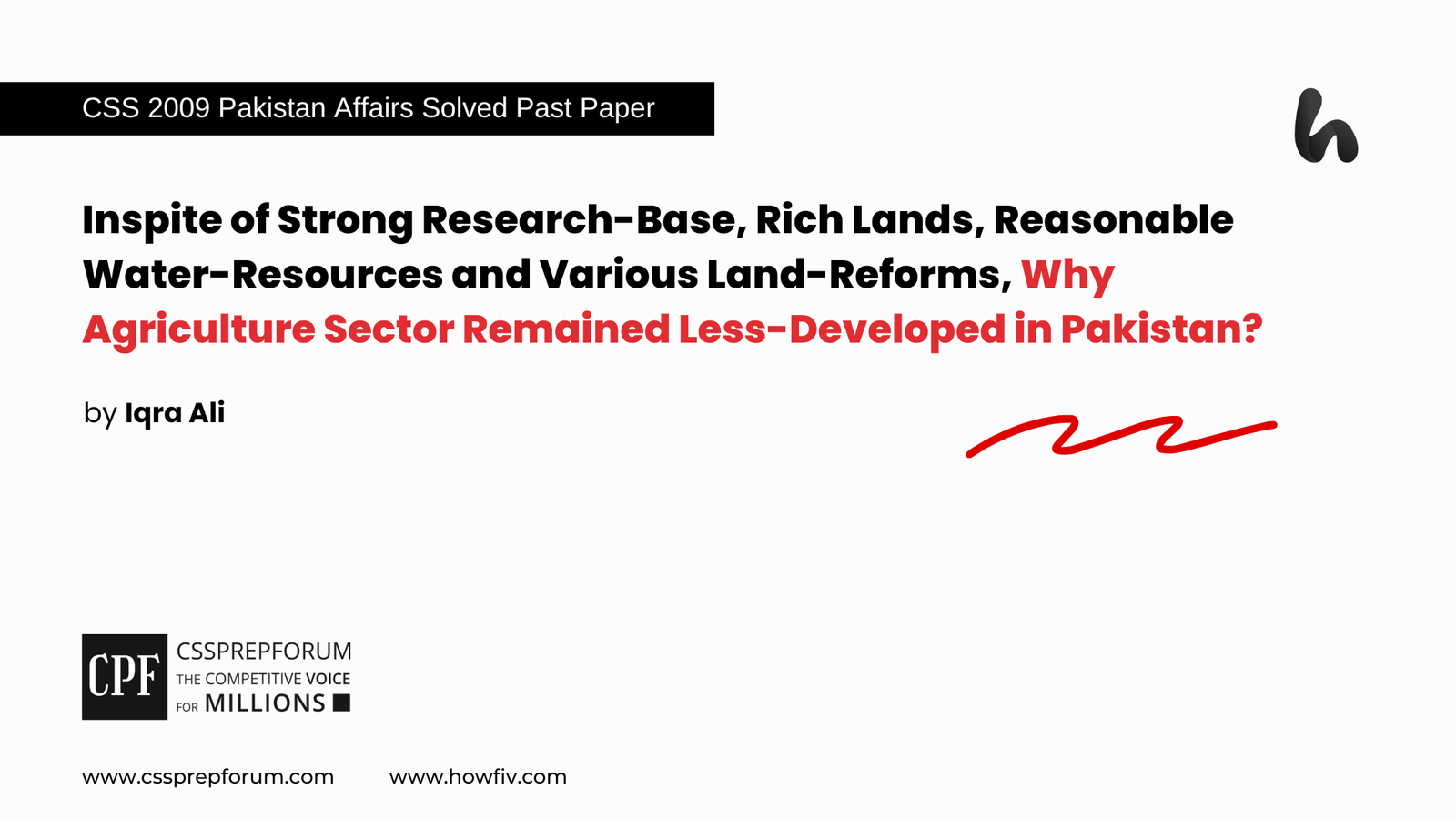The CSS Solved General Science & Ability (GSA) Past Paper 2017 is Solved by Pakistan’s top GSA Coaches, Miss Iqra Ali and Sir Ammar Hashmi. They are the only coaches available in Pakistan who have solved the last 20 years GSA solved papers to help aspirants know how to attempt the paper to score above 80. And they have guided thousands of CSS and PMS aspirants. Both coaches have been known for their teaching methodology and imparting concepts to their students, who scored the highest marks in this subject. At the special request of CSSPrepForum, both coaches have solved the paper.

Question – 02
(A) What are the factors responsible for environmental pollution?
Question Breakdown
In this question, the examiner has asked you to explain the causes of environmental pollution. So, all you have to do is start with a simple definition of the subject matter and then give a brief description of all the factors divided into several categories and points for a better explanation. Making a chart or a mind map to visually aid the examiner in understanding the answer is also a good way to answer such questions.
Answer
Environmental Pollution:
The word pollution has its origin in the Latin word “Polluere” which means “to contaminate”. So, environmental pollution, in simple words, can be defined as the contamination of any feature of the environment or any discharge of pollutants into water, land, or air that causes or may cause acute (short-term) or chronic (long-term) detriment to the Earth’s ecological balance.
Factors Affecting Environmental Pollution:
These sources/factors can be classified into two main categories:
1- Natural Factors/Sources:
The natural factors responsible for Environmental pollution refer to the various activities or sources which occur naturally and are responsible for the releasing of pollutants using any medium i.e., air, water, or land.
✓ Volcanic Eruption:
It emits a series of toxic gases into the atmosphere including Sulphur and chlorine as well as particulate matter. It also impacts the water quality. Moreover, it causes land pollution as it damages crops and destructs vegetation.
✓ Bacterial and microbial activity:
Their decaying process can release a variety of gases into the atmosphere especially methane gas which at the end causes environmental pollution.
✓ Radioactivity:
The radioactive decay releases radon into the atmosphere.
✓ Wildfires:
They can cause both air and land pollution.
2- Anthropogenic Factors/sources:
The factors which contribute to environmental pollution because of manmade activities are called anthropogenic sources. Following are some factors.
✓ Burning of different kinds of fuels:
The usage of such non-renewable energy resources results in environmental pollution. For instance, hydrocarbon gas released as a result of fossil fuel burning plays a vital role in the phenomenon of global warming.
✓ Chlorofluorocarbons (CFC):
They disrupt the whole process of the natural greenhouse effect as they have a very high global warming potential.
✓ Waste deposition in landfills:
It results in the pollution of land as well as water pollution.
✓ Military/Defense Military Practices:
During practices, certain chemicals and gases are released into the atmosphere that causes environmental pollution.
✓ Industrial Waste Effluents:
Since the beginning of the industrial revolution, industrial wastes have been one of the biggest factors responsible for polluting the environment.
✓ Oil Spills and transportation:
The use of automobile engines is also attributed to environmental pollution.
✓ Fertilizers and Sewage-Agricultural activities:
The use of pesticides as well as the whole process of its sewage results in water and land pollution. Moreover, the burning of crop residues has its part in air pollution.
(B) Briefly explain the main reasons for water-logging in Pakistan.
Question Breakdown
In this question, the examiner has asked you to explain the factors behind water logging. So, all you have to do is start with a simple definition of the subject matter and then give a brief description of all the factors. Making a chart or a mind map to visually aid the examiner in understanding the answer is also a good way to answer such questions. Moreover, alluding to the effects and solutions can also help you get good marks.
Answer
Water logging:
It refers to the saturation of soil with water. When the conditions are so created that the crop root zone gets deprived of proper aeration because of the presence of excessive water content, the soil is said to be waterlogged.
Reasons for Water Logging in Pakistan:
Waterlogging is one of the most severe impediments to the agricultural productivity of irrigated lands in Pakistan. It, along with salinity, is responsible for 25% of the affected irrigated land, resulting in the reduction of crop yields. Following are the reasons behind water logging in Pakistan:
✓ Heavy Rainfall and inadequate drainage of the surface run-off:
During the rainy season, the upper layers of soil become highly saturated with water in case of heavy rainfall and floods. The Inadequate drainage of the overland run-off causes the percolation level to increase, which, in turn, raises the water table.
✓ Over irrigation of fields:
Farmers, due to the lack of proper awareness, depend on excessive irrigation in cultivating certain crops. Excessive irrigation and lack of adequate drainage systems cause an increase in water logging.
✓ Seepage from Canals:
Seepage from earthen canals also adds a significant quantity of water to the underground reservoir continuously. In Pakistan, the canals are constructed in such a way that the water level in them is much above the surface of the soil to be irrigated. Thus, It results in an increase in water logging.
✓ By breaking hardpan at a canal bed:
During cleaning season, the digging of canals breaks down the hardpan of the soil at the canal bed. It also enhances the seepage of water to adjacent soil and results in water logging.
(C) What do you mean by Ozone depletion and how we can prevent its depletion?
Question Breakdown
In this question, the examiner has asked you to define Ozone depletion and give suggestions to prevent the phenomenon. So, all you have to do is begin with definitions of the Ozone Layer and Ozone depletion. Then, elude the factors responsible for the phenomenon. Afterwards, give ways to prevent further depletion of the Ozone Layer. Making a diagram and being creative can help you gain good marks on such questions.
Answer
Ozone Layer:
Ozone, a gas found in the atmosphere in trace amounts, can both be beneficial or detrimental depending on where it is located. The ozone layer is a region in the earth’s stratosphere that contains high concentrations of ozone and protects the earth from the harmful ultraviolet radiations of the sun.
Ozone layer depletion:
Ozone layer depletion is the thinning of the ozone layer present in the stratosphere layer of the atmosphere.
Causes of Ozone layer depletion:
This happens when the chlorine and bromine atoms in the atmosphere come in contact with ozone and destroy the ozone molecules. One chlorine can destroy 100,000 molecules of ozone. Chlorofluorocarbons themselves do not destroy ozone molecules themselves but they decay chlorine and bromine on exposure to high ultraviolet light, which then contributes to ozone layer depletion. Such compounds are known as Ozone Depleting Substances (ODS).
CCl3F + UV light → Cl + CCl2F
CCl2F2 + UV light → Cl + CClF2
Cl + O3 → ClO + O2
ClO + O → Cl + O2
The ozone-depleting substances that contain chlorine include chlorofluorocarbon, carbon tetrachloride, hydrochlorofluorocarbons, and methyl chloroform. Chlorofluorocarbons are the most abundant ozone-depleting substance. It is only when the chlorine atom reacts with some other molecule that it does not react with ozone. Following is the list of some main ozone-depleting substances and the sources from where they are released:
| Ozone-Depleting Substances | Sources |
| Chlorofluorocarbons (CFCs) | Refrigerators, air-conditioners, solvents, dry-cleaning agents, etc. |
| Halons | Fire-extinguishers |
| Carbon tetrachloride | Fire-extinguishers, solvents |
| Methyl Chloroform | Adhesives, aerosols |
| Hydrofluorocarbons | Fire extinguishers, air-conditioners, solvent |
Solutions to Ozone Layer Depletion:
The depletion of the ozone layer is a serious issue and various programs have been launched by the government of various countries to prevent it. Montreal Protocol was proposed in 1987 to stop the use, production, and import of ozone-depleting substances and minimize their concentration in the atmosphere to protect the ozone layer of the earth. However, steps should be taken at the individual level as well to prevent the depletion of the ozone layer. Following are some points that would help in preventing this problem at a global level:
1- Avoid Using ODS:
Reduce the use of ozone-depleting substances. E.g. avoid the use of CFCs in refrigerators and air conditioners, replace the halon-based fire extinguishers, etc. Hydrofluoroolefin (HFO) refrigerants should be used as they have the lowest global warming potential (GWP).
2- Minimize the Use of Vehicles:
The vehicles emit a large number of greenhouse gases that lead to global warming as well as ozone depletion. Therefore, the use of vehicles should be minimized as much as possible.
3- Use Eco-friendly Cleaning Products:
Most cleaning products have chlorine and bromine-releasing chemicals that find their way into the atmosphere and affect the ozone layer. These should be substituted with natural products to protect the environment.
4- Use of Nitrous Oxide should be Banned:
The government should take action and prohibit the use of harmful nitrous oxide that is adversely affecting the ozone layer. People should be made aware of the harmful effects of nitrous oxide and the products emitting the gas so that its use is minimized at the individual level as well.
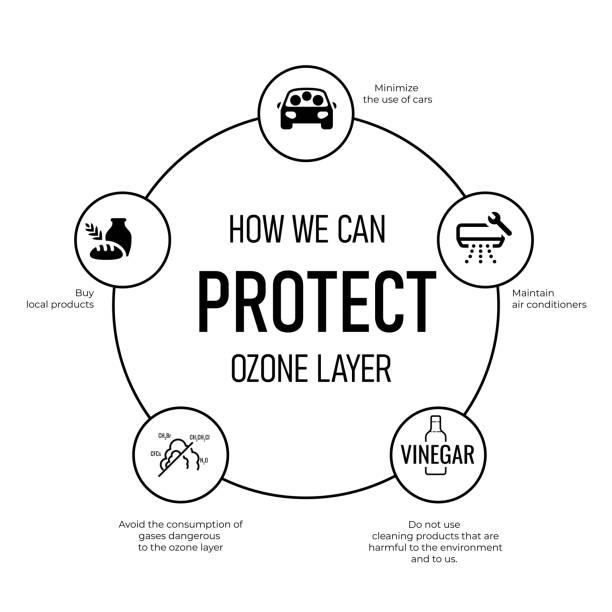
(D) What is Acid Rain and how it is produced? Briefly describe the dangers associated with it.
Question Breakdown
In this question, the examiner has asked you to define acid rain and elaborate on its formation. Afterwards, you are required to mention its harmful impacts. Thus, you may simply begin with the definition of the acid raid and, shedding some light on the process of its formation (adding the relevant chemical equations for maximum score), move towards its impacts on life. The impacts or dangers associated with the phenomenon can be elucidated in various categories, eg. impacts on plants, animals, infrastructure, etc.
Answer:
Acid rain:
Acid Rain, as the name suggests, can be described as the precipitation of acid in the form of rain in the simplest manner. When atmospheric pollutants like oxides of nitrogen and Sulphur react with rainwater and come down with the rain, and consequently, results in Acid Rain.
How acid rain is produced?
It can be produced both as dry as well as wet deposition form.
✓ Wet deposition:
The causes of wet deposition of acid rain are when Sulphur and Nitrogen particles get mixed with the wet components of rain. Sulphur and Nitrogen particles get mixed with water and form different acids i.e., sulphuric acid and nitric acid.
2SO2 (g) + O2 (g) + 2H2O (l) → 2H2SO4 (aq)
4NO2 (g) + O2 (g) + 2H2O (l) → 4HNO3 (aq)
They can be formed in two ways either man-made i.e., as the emissions that are given out from industries or by natural causes like lightning strikes in the atmosphere releasing nitrogen oxides and volcanic eruptions releasing sulphur oxide.
✓ Dry deposition:
The oxides of nitrogen and sulphur are blown away by the wind along with the dust particles. They settle on the earth’s surface after coming down in the form of precipitation. Acid rain is essentially a by-product of human activities which emit oxides of nitrogen and sulphur into the atmosphere. Examples – the burning of fossil fuels, and unethical waste emission disposal techniques.
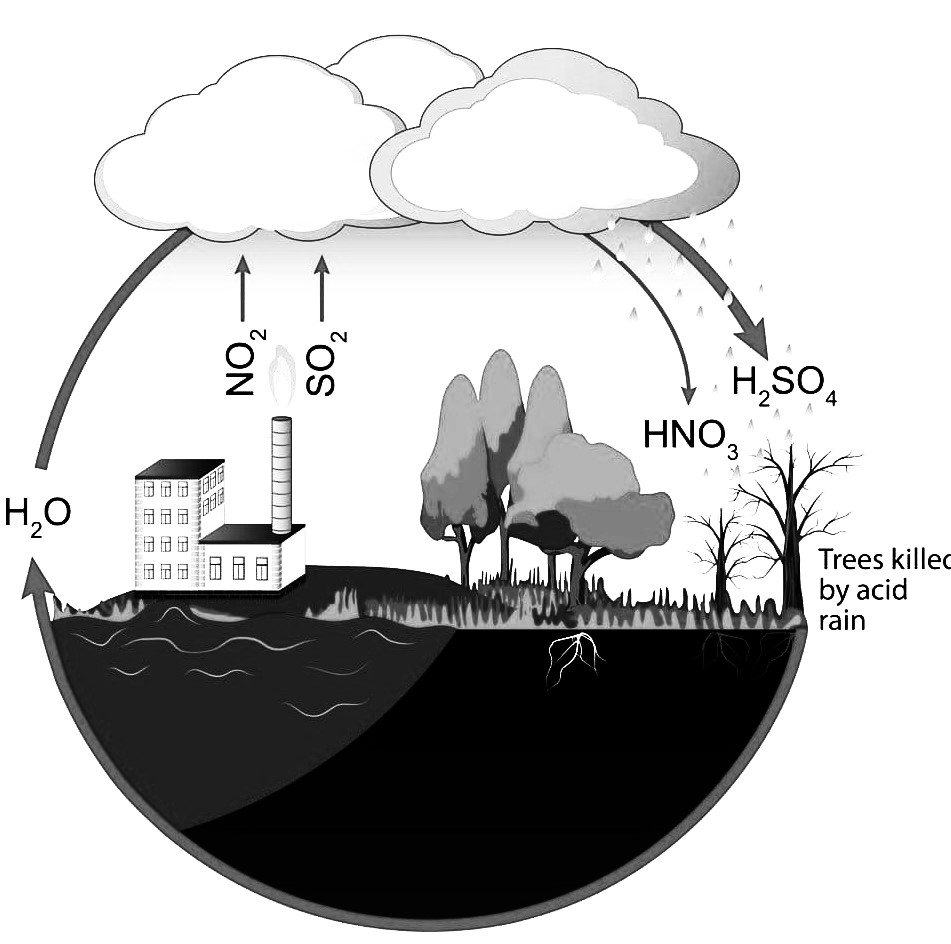
Dangers associated with acid rain:
✓ Risk for Surface Water and Aquatic Animals:
Some minerals like aluminium are washed out from the ground surface as a result of acid rain and as a result, they poison lakes and affect aquatic life. Fish eggs do not hatch at such a low pH. Moreover, the lower pH can cause damage to fish and other aquatic animals. For instance, biodiversity is reduced as the lakes and rivers have become acidic.
✓ Damage Soil:
The physical as the well biological composition of the soil is damaged as a result of acid rain. The trees and plants are also damaged because of certain chemical reactions taking place on the surface of the soil as a result of acid rain.
✓ Adverse effects on human health: Along with skin diseases and hair damage, acid rain can also cause some serious pulmonary as well as heart problems in humans.
✓ Destructive vegetation and forests: The acids take and wash away some important minerals from the surface of the soil which as a result causes the reduced growth of plants and forests. Moreover, acid rain makes it even easier for fungi and insects to attack trees and, consequently, trees start to die.
✓ Harmful for historical buildings: It can also damage buildings and historic monuments as well as statues especially those made of rocks and the ones that contain calcium carbonate. The acids present in the lakes react with calcium carbonate and make gypsum, which, consequently, flakes off.
CaCO3 (s) + H2SO4 (aq) = CaSO4 (aq) + CO2 + H2O

Question – 03
(A) Explain in detail the common causes of Heart Attacks.
Question Breakdown
In this question, the examiner has asked you to explain the factors leading to a Heart Attack. Begin the answer by understanding the phenomenon and then explaining the various causes of the disease. Being creative can help you gain good marks on such questions.
Answer
Heart Attack:
Heart attack is a severe heart disease that mainly occurs when the blood supply to the heart is suddenly interrupted. Its biological name is myocardial infarction. Heart attacks are caused by the sudden interruption of blood supply to the heart. As a result, heart muscles may be damaged and begin to die. At the time, when a large portion of the heart is damaged, the heart stops beating (known as a cardiac arrest), resulting in death.
Causes of Heart Attack:
Following are some of the significant causes of a heart attack.
✓ Family history:
There is an increased probability of heart attack in a person with a family history of heart disease. Some people are born with heart diseases which can cause a heart attack if not treated on time.
✓ Smoking:
Smoking increases the heart attack risks and the tendency for blood clotting. Acrolein- a chemical found in cigarettes- leads to the buildup of a waxy plaque in the arteries. At the particular site, the arteries get narrower and constrict the blood supply to the heart. Consequently, the heart muscles begin to starve, which eventually leads to a heart attack.
✓ High cholesterol:
A high level of cholesterol in the blood leads to the buildup of a waxy substance called plaque in the arteries in a process called atherosclerosis, wherein the arteries get narrower, constricting blood supply to the heart and causing a heart attack.
✓ Overweight:
Being overweight contributes to the risk of a heart attack. The heart has to beat with more pressure to send blood through the veins causing high blood pressure or hypertension. This eventually weakens the heart because it cannot continue to pump hard against the pressure in blood vessels which causes a heart attack.
✓ Drug misuse:
Drugs like cocaine, heroin and alcohol interfere with the normal functioning of the heart by causing abnormal heartbeat and by interrupting blood circulation. A large quantity of these drugs always results in a heart attack.
✓ Lack of oxygen (hypoxia):
If the level of oxygen in the blood decreases due to carbon dioxide poisoning or suffocation, the heart will receive un-oxygenated blood, which will damage a large portion of the heart and trigger a heart attack.
(B) Differentiate between drug addiction and drug abuse.
Question Breakdown
In this question, the examiner has asked you to explain the difference between drug addiction and abuse. For answering such questions, simply, make a table and start writing differences according to several characteristics like definitions, examples, signs, etc. Remember, in a single point, only write the differences that are relevant to one characteristic; for instance, do not write the definition of drug addiction and examples of drug abuse in one point.
Answer
| Characteristics | Drug Addiction | Drug Abuse |
| Define | Drug addiction is a disease that alters a person’s brain and behaviour where they are unable to stop using legal or illegal substances. | Drug abuse involves using legal or illegal substances in ways that you should not. |
| Examples | Someone struggling with addiction may continue using the drug despite being aware of its negative consequences. | One may take more than the recommended dose of a drug or use someone else’s prescription pills. |
| Consequences | Frequent drug use can cause changes in one’s brain, impacting self-control and interfering with their ability to resist urges. | The worst consequence of abusing drugs is its ability to develop into drug dependency or drug addiction. |
| Physical Signs | •Weight loss or weight gain •Irregular sleeping patterns •Tremor or seizures •Loss of physical coordination •Extreme lethargy eyes | •Nausea or vomiting •Poor hygiene •Irregular heartbeat •Runny nose •Sleep problems |
| Behavioural Signs | •Self-isolation •Financial and legal issues •Secretive behaviour •Repeated dishonesty •Drop in performance at school or work | •ParanoiaIrritability •Stealing money or items •Lack of motivation •Sudden over sensitivity |
| Withdrawal symptoms | Withdrawal symptoms are the major sign of addiction | It is not associated with withdrawal symptoms |
| Dependence | Physical dependence | Psychological dependence |
| Use of substance | Chronic use | Recreational or casual use |
(C) Draw the structure of the human ear and briefly explain its functions.
Question Breakdown
In this question, the examiner has asked you to explain the structure and functions of the human ear. First, delineate the parts of the ear with an explanation. Then, write down the functions of the human ear. To score maximum marks, add a labelled diagram of the ear and its parts. Remember, being creative is the key to attaining a good score in the General Science and Ability paper.
Answer
Human Ear:
The ear is an organ that takes sound waves and turns them into something our brain can understand. It determines the direction of the sound, which is then processed by the brain.
Structure of the Ear:
There are three major parts of the ear that help us to share.
1- The outer ear:
The part of the ear that is seen from outside the head is called the outer ear. It contains the auricle pinna, the ear canal, and the ear drum-tympanum.
2- The middle ear:
It is a cavity with three important ear bones, an anvil, stirrup, and hammer, linked to one another. In addition, the lower part of the middle ear has a Eustachian tube that connects the middle ear to the respiratory tract and ensures that the air pressure inside the middle ear is the same as that on the outside.
3- The inner ear:
The inner ear has a coiled tube- cochlea, one side of which is connected to the middle ear through an elastic membrane over the oval window and the other side is connected to the auditory nerve going to the brain.
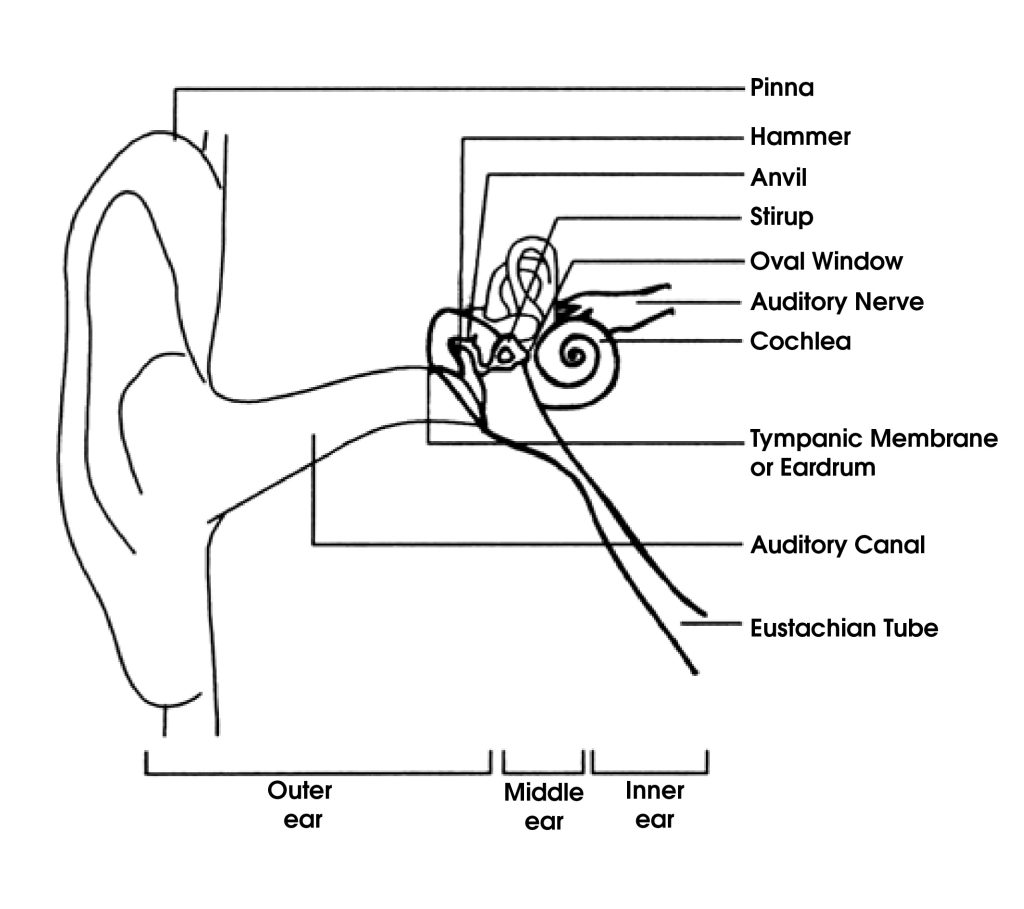
Functions of the Ear:
1- Hearing:
The hearing mechanism involves the following steps:
•The sound waves travel through the auditory canal to the eardrum.
•The vibrations produced at the eardrum pass to the tympanic cavity through the tympanic membrane.
•In the tympanic cavity, the ear ossicles receive vibrations, and the stirrup pushes the window in and out.
•The action is then passed on to the organ of Corti- a hearing receptor that translates the vibrations into an electrical impulse, which is then transmitted to the brain via sensory neurons.
2- Balance:
The vestibular complex and the eustachian tube are two essential parts of the ear responsible for balance.
•The eustachian tube stabilizes the air pressure in the middle ear and maintains the balance.
•The vestibular complex contains receptors that maintain body balance.
-Coordination of eye and head movements.
-Postural equilibrium- the coordination of joint movements to stabilize body motion during both static and self-initiated dynamic stances
(D) What is the significance of Vitamins? Describe the sources, uses and deficiency symptoms of fat-soluble vitamins.
Question Breakdown
In this question, the examiner has asked you to explain the importance of vitamins, their uses, sources, and symptoms of a less than required intake. So, first, define vitamins and write down bullet points explaining their importance. Then, make a table and elucidate the types of vitamins, their sources, uses, and deficiency symptoms. Remember, being creative is the key to attaining a good score in the General Science and Ability paper.
Answer:
Vitamins
An organic component that is essential for normal growth in the human body and required in a small quantity for proper functioning of metabolism is called vitamins.
Significance of vitamins:
✓ Vitamins build up the resistance of the body against diseases
✓ Vitamins prevent and cure various diseases caused by a deficiency
✓ Vitamins help the digestion and utilization of mineral salts and carbohydrates in the body
✓ Vitamins stimulate and give strength to the digestive and nervous system
Classification of vitamins:
There are categories of vitamins that are discussed below:
1- Fat-soluble vitamins
2- Water-soluble vitamins
Sources, Uses and Deficiency Symptoms of Fat Soluble Vitamins
| Vitamin | Sources | Uses | Deficiency symptoms |
| Vitamin A (Retinol) | •Fortified milk •Cheese Cream •Deep Green vegetable •Fruit | •Component of the visual pigments •Required for the maintenance of epithelial tissue •Helps Prevent damage to the lipid membrane •Antioxidant | •Night blindness •Dry eyes •Rough skin •Slower bone growth •Proper tooth development |
| Vitamin D | •Egg yolks •Liver •Fatty fish •Sunlight exposure | •Aids in absorption of calcium and phosphorus in bones | •Cancer •Rickets •Softening of the bone |
| Vitamin E | •Polyunsaturated plant oils •Whole-grain products •Egg yolks •Nuts and seeds | •Antioxidant •Protects cell walls | •Muscular weakness and •Neurological dysfunction |
| Vitamin K | •Leafy green vegetables •Tea •Produced in the intestinal tract by bacteria | Needed for proper blood clotting | •Difficulty in Blood clotting •Reduces the bone density |
Question – 04
(A) What is a mirage? Describe in detail the creation of the mirage.
Question Breakdown
In this question, the examiner has asked you to define and explain the phenomenon of mirage. So, simply begin by defining a mirage and then move on to explain its creation. You may also make a diagram to elucidate the effect; remember, being creative is the key to attaining a good score in the General Science and Ability paper.
Answer
Mirage:
A mirage, an image that looks real but is not really there, is a naturally occurring optical phenomenon, in which light rays refract near the surface due to different temperatures and thicknesses in the layers of air on the earth’s surface.
Creation of Mirage:
The air above the earth’s surface is scorching during hot summer days, and air at higher altitudes is cold. It means that temperature decreases with height, as air density increases with height, and the refractive index also increases. So, cooler air has a higher refractive index than the hotter air above the road. Therefore, light travels faster through thinner hot air than dense cold air. When light from a tree passes through the medium just above ground whose refractive index decreases towards the ground it suffers total internal reflection and takes the curved path. This appears as the ray is reflected from the ground. Hence we feel the illusion of water being present on the road. The inverted virtual image seen by the observer is called the mirage.

(B) Differentiate between the occurrence of Lunar and Solar Eclipse?
Question Breakdown
In this question, the examiner has asked you to explain the difference between solar and lunar eclipses. For answering such questions, simply, make a table and start writing differences according to several characteristics like definitions, diagrams, types, etc. Remember, in a single point, only write the differences that are relevant to one characteristic; for instance, do not write the definition of solar eclipse and the structure of lunar eclipse in one point.
Answer
| Basis of differentiation | Solar eclipse | Lunar eclipse |
| Definition | A solar eclipse happens when the moon passes in between the earth and the sun. During a solar eclipse, the moon partially or fully hides the sun’s rays for a few minutes. | A lunar eclipse happens when the earth passes in between the moon and the sun. During a lunar eclipse, the earth’s shade partially or fully hides the moon for a brief period of time. |
| Eclipse and its types | It has three types of solar eclipses namely •Partial solar eclipse •Annular solar eclipse •Total solar eclipse | The lunar eclipse has two types namely •Partial lunar eclipse •Total lunar eclipse •Penumbral lunar eclipse |
| Frequency of occurrence | It occurs usually once in eighteen months during the daytime | It happens twice a year during the nighttime. |
| Duration | The longest duration is around 7 and a half minutes. | The time period of the lunar eclipse almost is an hour |
| Form of Appearance | In this form of the eclipse, a bright disk of sunlight is seen around the new moon. | In the lunar eclipse, the moon appears slightly reddish in colour |
| Phases of moon | The solar eclipse happens in the new moon phase | The lunar eclipse happens in the full moon phase |
| Risk for health | It cannot be seen directly through naked eyes, because of the high chance of losing vision as it can damage the retina. | Meanwhile, in comparison, watching a lunar eclipse with the naked eye is absolutely safe. |

(C) Briefly explain what effects are produced due to the Rotation & Revolution of Earth.
Question Breakdown
In this question, the examiner has asked you to explain the phenomena occurring due to the rotation and revolution of Earth. So, all you have to do is define each term and delineate the effects caused by it. You can grab the maximum score by making your answer stand out by drawing labelled diagrams of both processes.
Answer
Rotation and revolution are the phenomena associated with celestial objects. Likewise, these phenomena are also linked with Earth too. To understand the effects of Earth’s rotation and revolution, first, a brief understanding of these phenomena is important.
Rotation of Earth:
A rotation is the earth’s movement around its axis, usually called the axis of rotation. The axis of rotation passes through the centre of mass of the earth. It is a synonym for spinning.
Effects Produced due to the Rotation of earth:
The spinning of the Earth around its axis is called rotation. The Earth rotates from West to East (counter-clockwise), and the axis is tilted at 23.5 degrees. The rotation of the Earth causes the occurrence of day and night. It is also responsible for the occurrence of tides in the ocean. The portion of the Earth’s surface that faces the Sun will have a day, and the other parts will have night. The Earth takes about 23 hours, 56 minutes, and 4 seconds to complete its one rotation.

Revolution of Earth:
Revolution of the earth means the movement of the earth around the Sun. It is referred to the orbital motion of an object.
Effects Produced due to the Revolution of the earth:
The movement of the Earth around the Sun in a fixed path is called revolution. It revolves in an elliptical orbit from west to east, i.e., in the anticlockwise direction. And it is responsible for the occurrence of seasons like summer, winter, etc. During the motion, the distance between the Earth and Sun changes, which causes variation in weather. It takes about 365.25 days to complete one revolution around the Sun. The speed of the Earth is about 30km/sec while moving around the Sun.
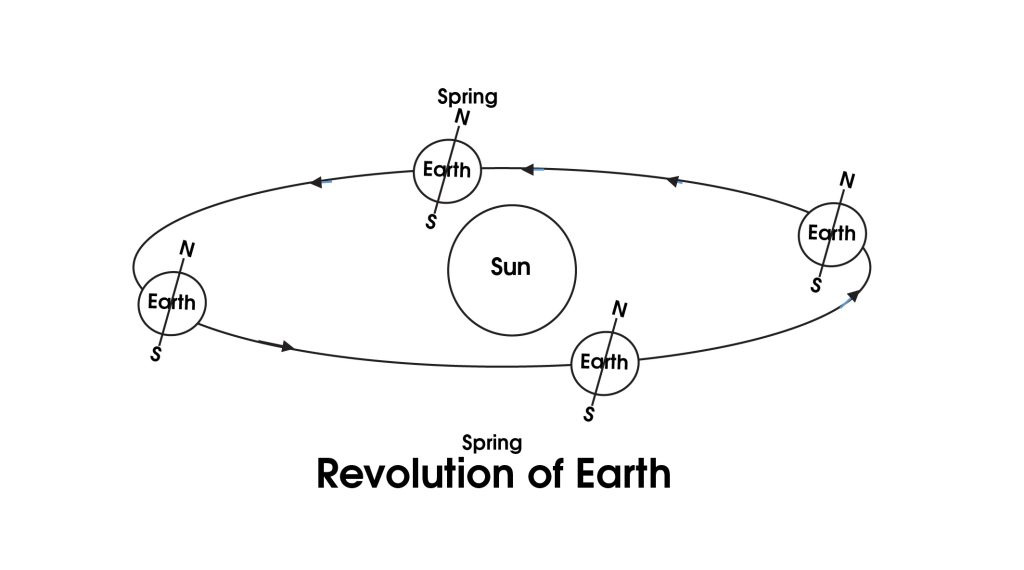
(D) Most of the household appliances utilize ‘DC’ then why do we generate ‘AC’ at power stations?
Question Breakdown:
In this question, the examiner has asked you the reasons for generating alternating current at the power station. So, simply begin by defining a mirage and then move on to explain its creation. You may also make a diagram to elucidate the effect; remember, being creative is the key to attaining a good score in the General Science and Ability paper.
Answer:
Alternating and Direct Current (AC and DC):
An alternating current is one in which direction is continuously changed because of the back-and-forth movement of the electrons. Unlike AC current, a direct current flows in one direction without any change in the frequency.
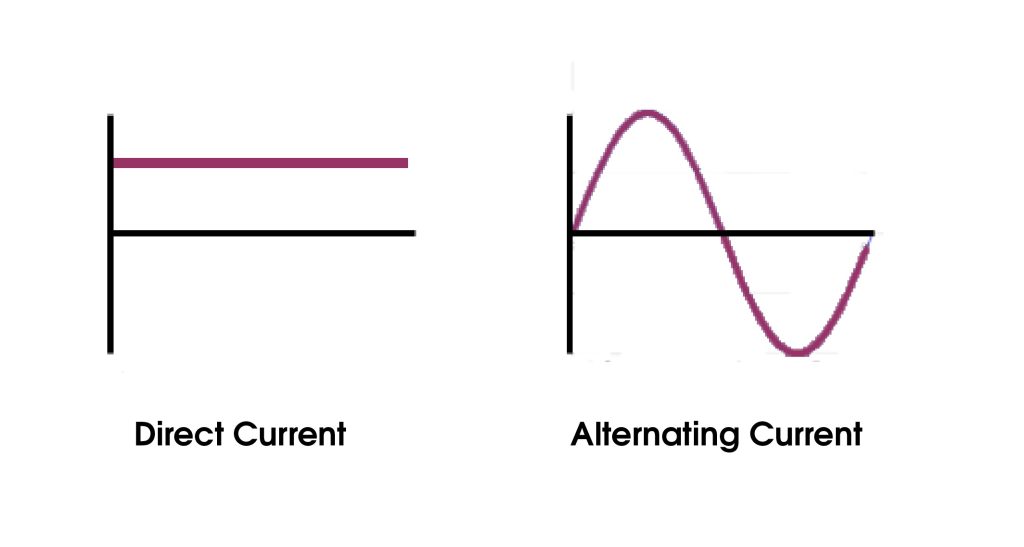
Reason for Generating AC at power stations:
There are a few reasons behind generating alternating current (AC) at power stations, while most of the appliances use direct current (DC).
✓ The voltage through alternating current can be readily changed, thus making it more suitable for long-distance transmission than DC electricity.
✓ The alternating current AC can easily be converted into direct current, whereas it is difficult and expensive to convert DC into AC. Hence, it is suitable to generate alternating current AC at power stations as compared to direct current DC.
✓ Transformers at power stations depend upon the availability of alternating current to operate because before reaching the home appliances, the current has to pass through a transformer that runs at the phenomenon of mutual induction. The mutual induction is produced in the transformer because of AC as it is able to change its current direction and cause a change in magnetic flux, ultimately making current in the secondary wire, and the power distribution grid also depends on transformers.
✓ Large electrical generators generate alternating current naturally, so conversion to DC would involve an extra step. Therefore, generating and transporting AC across long distances is relatively easy.

Question- 05
(A) Differentiate between RAM and ROM?
Question Breakdown
In this question, the examiner has asked you to explain the difference between the RAM and ROM. For answering such questions, simply, make a table and start writing differences according to several characteristics like definitions, data retention, uses, speed, size and capacity, cost, etc. Remember, in a single point, only write the differences that are relevant to one characteristic; for instance, do not write the definition of solar eclipse and structure of lunar eclipse in one point.
Answer
| Characteristics | RAM | ROM |
| Data retention | RAM is a volatile memory which could store data as long as the power is supplied. | ROM is a non-volatile memory which could retain the data even when power is turned off. |
| Working type | Data stored in RAM can be retrieved and altered. | Data stored in ROM can only be read. |
| Use | Used to store the data that has to be currently processed by CPU temporarily. | It stores the instructions required during the bootstrap of the computer. |
| Speed | It is a high-speed memory. | It is much slower than the RAM. |
| Size and capacity | Large size with higher capacity. | Small size with less capacity. |
| Cost | Costly as compared to ROM | Cheaper than RAM |
(B) Name three basic buses employed in a computer and explain what each is used for?
Question breakdown
In this question, the examiner has asked you to explain the buses of computers and their uses. Thus, start your answer by writing a basic definition of a computer. Then, describe all the three buses comprehensively yet clearly. In the end, draw the relevant diagram depicting the function of each bus. Remember, writing too much never ensures your good marks in the exams. However, what helps your paper stand out among other aspirants is the way you present them.
Answer
Computer:
A Computer bus consists of a set of parallel conductors that may be conventional wires, copper tracks on a printed circuit board, or microscopic aluminium trails on the surface of a silicon chip.
Buses of Computer System
Three basic buses employed in a computer are the following:
1- Address bus:
Address bus carries memory addresses from the processor to other components, such as primary storage and input/output devices. The address bus is unidirectional.
2- Data bus:
A data bus is a data-centric framework that distributes and manages real-time data between the processor and other components in intelligent distributed systems. It allows applications and devices to work together as one integrated system. The data bus system is bi-directional.
3- Control bus:
The control bus carries control signals from the processor to other components and ensures everything flows smoothly from place to place. The control bus is unidirectional.

(C) Draw a basic computer block diagram and briefly explain the function of each part.
Question Breakdown
In this question, the examiner has directly asked you to draw a block diagram of a computer and elucidate the function of each part. So, all you have to do is to make a simple diagram showing the connection of each part of a computer with the other parts. Then, you need to explain the functions that these parts perform. Do not forget to accurately label the diagram.
Answer
Computer:
A computer is a digital electronic machine that is programmed to carry out sequences of logical or arithmetic operations automatically.
Block Diagram of Computer:

The function of Parts of the Computer:

(D) Describe various types of computers classified on the basis of size, memory, capacity and speed.
Question Breakdown
In this question, the examiner has simply asked you to classify a computer on the basis of size, memory, and capacity. Remember; do not get confused on the basis of the classification being asked. It is the same classification named super-computer, mini-computer, micro-computer, and a mainframe computer. Although making a diagram is not necessary, drawing of the major types of computers can improve the presentation of your question.
Answer:
Computer:
A computer is a digital electronic machine that is programmed to carry out sequences of logical or arithmetic operations automatically.
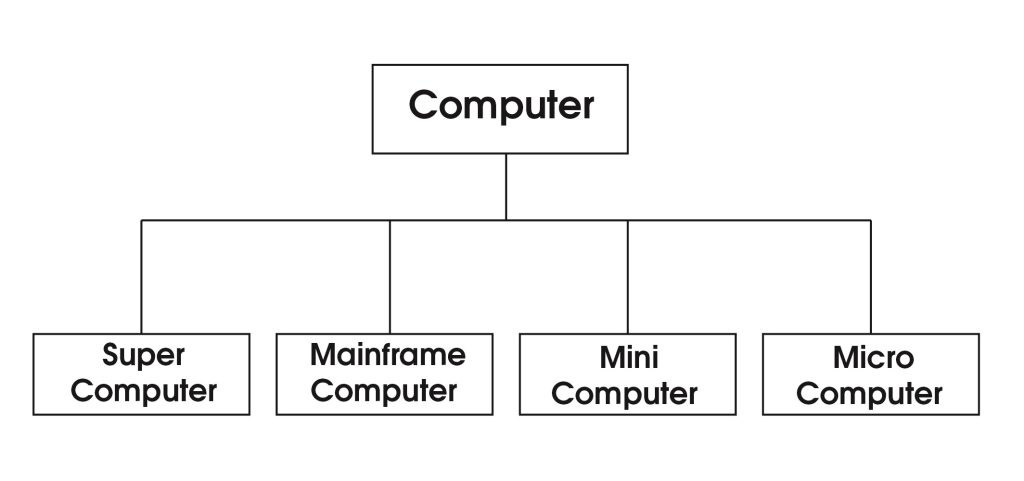
Types of Computer:
Based on the size, memory, capacity, and speed, there are mainly four types of computers.
1- Super Computer
The most powerful computers in terms of performance and data processing are Supercomputers. These are specialized and task-specific computers used by immense organizations for research and exploration purposes, for example, computers in NASA. The supercomputers are of very large size and are very expensive. It can be accommodated in large all-conditioned rooms; some super computers can span an ensure building.
2- Mainframe Computer
Although Mainframes are less powerful than supercomputers, certainly they are quite expensive nonetheless, and many large firms & government organizations use mainframe computers to run business operations. These can be accommodated in large air-conditioned rooms because of their size.
3- Mini Computer
Minicomputers are used by small businesses & firms. Minicomputers are also called midrange computers and are small machines. These can be accommodated on a disk with not as processing and data storage capabilities as super-computers & Mainframes.
4- Micro Computer
Desktop computers, personal digital assistants (PDA), laptops, smartphones, and tablets are examples of microcomputers. These are widely used & the fastest growing computers. Microcomputers are the cheapest among the other three types of computers.
Writing meaningful sentences, lines, paragraphs, and blogging helps children maintain positivity, sharpen their intellect, and think purposefully. Let’s get your kid(s) registered & turn him a youngest blogger!
Kids Online Writing Course

Question – 06
(A) Differentiate with examples between a “Pictogram” and “Histogram”.
Solution:
| Histogram | Pictogram |
| It is a graph which is used to represent grouped data | It is the pictorial representation of large data in which pictures or symbols are used to represent data |
| It has continuous data | It has large data |
| No ‘key’ is required | ‘Key’ is required |
| It makes the data very easy to be comprehended | It makes the data look very presentable and attractive |
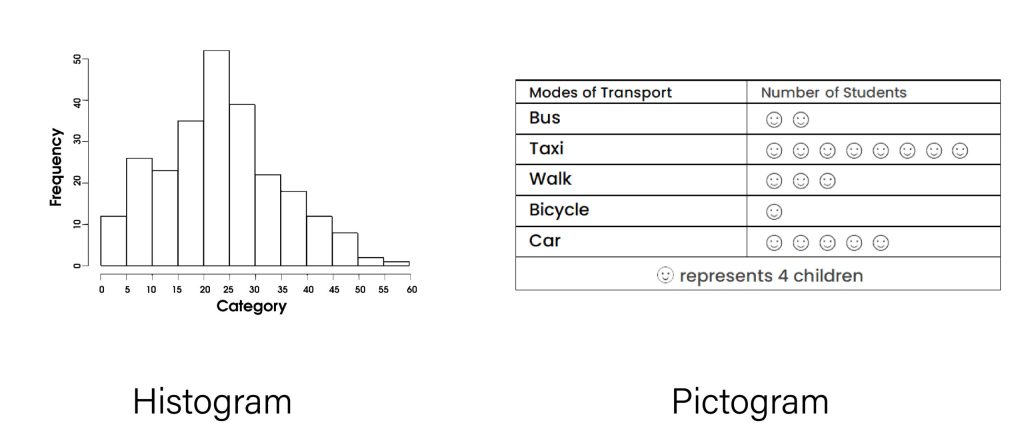
(B) The teachers of a certain school were asked to indicate the average number of hours they spend on marking students’ assignments each day. The following set of data was obtained
6 4 3 1 2 2 3 1 4
1 2 5 3 4 5 2 2 3
3 1 2 2 3 1 4 2
Construct a frequency table and draw a Histogram illustrating the results.
Solution:
- Frequency Table:
| NO OF HOURS | TEACHERS/FREQUENCY |
| 1 | 05 |
| 2 | 08 |
| 3 | 06 |
| 4 | 04 |
| 5 | 02 |
| 6 | 01 |
| T= 21 | T= 26 |
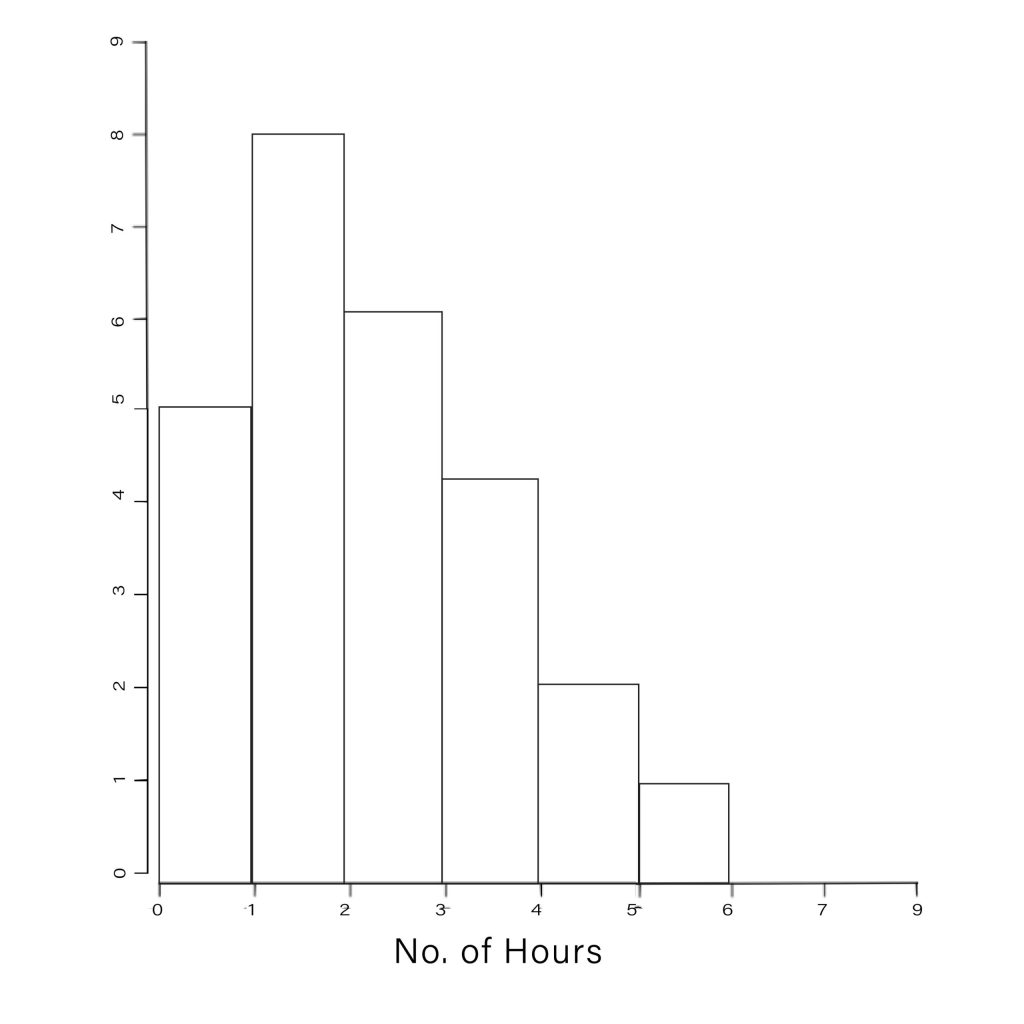
(C) How many teachers responded to the survey?
Solution:
We can see that in the frequency table the total number of frequencies is 26 which shows that a total of 26 teachers responded to this survey.
(D) What the longest number of hours and most common number of hours are spent?
Solution:
As shown in the frequency table, the longest number of hours is 6 which was responded to by only 1 teacher. Moreover, the most common no. of hours is 2 because 8 teachers responded in that period of time.
Question – 07
(A) A man buys 5kg of meat at Rs.500 per kg. In addition, for every kilogram of meat purchased, he has to pay a consumption tax of 6% on the selling price. Calculate the total amount of money that he has to pay.
Solution:
Amount per kg = 500
Total kg of meat= 5 kg
Total amount for 5kg = 500 x 5 = 2500 rupees
Consumption tax per kg = 6% of 500
= 6/100 x 500
= 30
Consumption tax for 5kg = 30 x 5 = 150 rupees
Now, we know that to get the amount that he has to pay, we have to add this consumption tax into the total amount of 5kg =
Amount to be paid = 2500 + 150
= 2650 rupees
(B) It takes Ali 30 minutes to mark a paper. Aslam only needs 25 minutes to mark a paper. If they both start marking papers at 10:00 AM, at what time they will finish marking at the same time?
Solution:
Time taken by Ali = 30 mints
Time taken by Aslam = 25 mints
Starting time = 10 AM
When will they finish at the same time = ?
BY PRIME FACTORIZATION METHOD WE GET:
30 = 2 x 3 x 5
25 = 5 x 5
We know that:
LCM = common factors x uncommon factors
= 5 x 2 x 3 x 5
= 150 mints
150 mint = 150/60 = 2.5 hours
So, they both will finish at the same time after 2.5 hours at 12:30 PM.
(C) Two bus tickets from Rawalpindi to Islamabad and three tickets from Rawalpindi to Murree cost Rs.770 but three tickets from Rawalpindi to Islamabad and two tickets from Rawalpindi to Murree cost Rs.730. What are the fares for cities Islamabad and Murree from Rawalpindi?
Solution:
Let the bus tickets from Rawalpindi to Islamabad = x
Let the bus tickets from Rawalpindi to Murree = y
Then, according to the given situation:
2x + 3y = 770 (1)
3x + 2y = 730 (2)
Before applying the method, we have to make the values of any variable equal so,
By multiplying equation (1) with 3 and equation (2) with 2 we get:
6x + 9y = 2310
6x + 4y = 1460
Now, by using the elimination method we get:
5y = 850
y = 850/5
y = 170
Now by putting this value in equation no 1 we get:
2x + 3 (170) = 770
2x + 510 = 770
2x = 770 – 510
2x = 260
X = 260/2 = 130
Hence, the fares are as follows:
From Rawalpindi to Islamabad = 130
From Rawalpindi to Murree = 170
(D) A told B that C is his father’s nephew. D is A’s cousin but not the brother of C. What relationship is there between D and C
Solution:
According to the given situation:
C = A’s father’s nephew = A’s cousin
D = also A’s cousin but not the brother of C
Let’s make a family tree
DIAGRAM
So, if we think logically and analyze the whole scenario, it is mentioned that D is not the BROTHER of C; however, it is not mentioned anywhere that D and C are not SIBLINGS. Thus, we can say that D is the SISTER of C.
Question – 08
(A) Divide Rs.500 between Arham, Mariam and Sarim so that Arham gets 2/3 of what Mariam gets and Mariam gets ¼ of what Sarim gets. Find the share of each.
Solution:
Total amount = 500 rupees
Let,
Share of Arham = A
Share of Mariyam = M
Share of Saarim = S
Total amount = A + M + S (a)
Now, according to the given scenario:
M = 1 /4 of S
A= 2/3 of M
Now by putting the value of M in A we get
A = 2/3 of ¼ S = 2/3 x 1/4 S
A = 1/6 S
Now by putting these values in equation (a)
500 = 1/6 S + 1/4 S + S
Now after taking LCM:
500 = 2S + 3S + 12S / 12
500 = 17S/12
17S = 500 x 12 = 6000
S = 6000/17
S= 352.94 = 353 rupees
Now, by putting these values in A and M we can get the value of shares of Arham and Mariyam as follows:
M = 1/4 of S
M = 1/4 x 353
M = 88.235 rupees
And,
A = 2/3 of M
A = 2/3 x 88.235
A = 58.823 rupees
(B) A school has enough provision food for 52 days. After 20 days a group of 400 students arrives and the food would last for 24 days only. How many students are there in the school actually?
Solution:
Provision of food duration = 52 days
After 20 days the duration would become = 52 – 20 = 32 days
Number of students who arrived after 20 days = 400
After their arrival, the food will last for = 24 days
Let the provision before the arrival of these students = x
Provision after their arrival = x + 400
X(32) = X+400 (24)
32X = 24X + 9600
32X – 24X = 9600
8X = 9600
X = 9600/8
X = 1200
It means, before the arrival of new students there were a total of 1200 students.
After the arrival of new students = X+400 = 1200 + 400 = 1600
(C) A man walks 2km towards North. Then he turns East and walks 10km. After this, he turns North and walks 3km. Again he turns towards the East and walks 2km. How far is he from the starting point?
Solution:

By using the Pythagorean theorem:

By taking under-root on both sides
(hyp) = 13
S0, he is 13km away from his starting point.
(D) In a certain code language COMPUTER is written as RFUVQNPC. How will MEDICINE be written in that code language?
Solution:
There are 8 letters in the word COMPUTER as well as in RFUVQNPC

Here, the technique/pattern to obtain the coded word can be by taking the immediately following letters of the word, except the first and the last letters of the given word but in the reverse order. It means, in the coded form, the first and the last letters have been interchanged while the remaining letters are coded by taking their immediate next letters in the reverse order i.e.,

So, the coded word for medicine would be written as EOJDJEFM
CSS Solved Past Papers’ Essays
Looking for the last ten years of CSS and PMS Solved Essays and want to know how Sir Kazim’s students write and score the highest marks in the essays’ papers? Then, click on the CSS Solved Essays to start reading them.
CSS Solved Essays

CSS Solved General Science & Ability Past Papers
| 1- | CSS Solved General Science And Ability Past Paper 2023 |
| 2- | CSS Solved General Science And Ability Past Paper 2022 |
| 3- | CSS Solved General Science And Ability Past Paper 2021 |
| 4- | CSS Solved General Science And Ability Past Paper 2020 |
| 5- | CSS Solved General Science And Ability Past Paper 2019 |
| 6- | CSS Solved General Science And Ability Past Paper 2018 |
| 7- | CSS Solved General Science And Ability Past Paper 2017 |
| 8- | CSS Solved General Science And Ability Past Paper 2016 |
| 9- | CSS Solved General Science And Ability Past Paper 2015 |
| 10- | CSS Solved General Science And Ability Past Paper 2014 |
| 11- | CSS Solved General Science And Ability Past Paper 2013 |
| 12- | CSS Solved General Science And Ability Past Paper 2012 |
| 13- | CSS Solved General Science And Ability Past Paper 2011 |
| 14- | CSS Solved General Science And Ability Past Paper 2010 |
| 15- | CSS Solved General Science And Ability Past Paper 2009 |
| 16 | CSS Solved General Science And Ability Past Paper 2008 |
| 17- | CSS Solved General Science And Ability Past Paper 2007 |
| 18- | CSS Solved General Science And Ability Past Paper 2006 |
| 19- | CSS Solved General Science And Ability Past Paper 2005 |
| 20- | CSS Solved General Science And Ability Past Paper 2004 |
| 21- | CSS Solved General Science And Ability Past Paper 2003 |
| 22- | CSS Solved General Science And Ability Past Paper 2002 |
| 23- | CSS Solved General Science And Ability Past Paper 2001 |
| 24- | CSS Solved General Science And Ability Past Paper 2000 |
Articles Might Interest You!
The following are some of the most important articles for CSS and PMS aspirants. Click on any to start reading.

